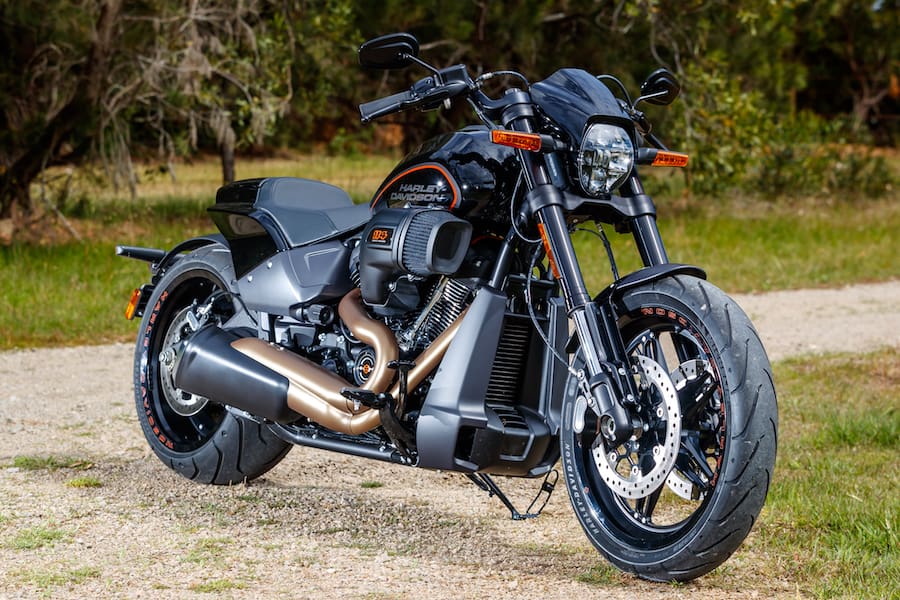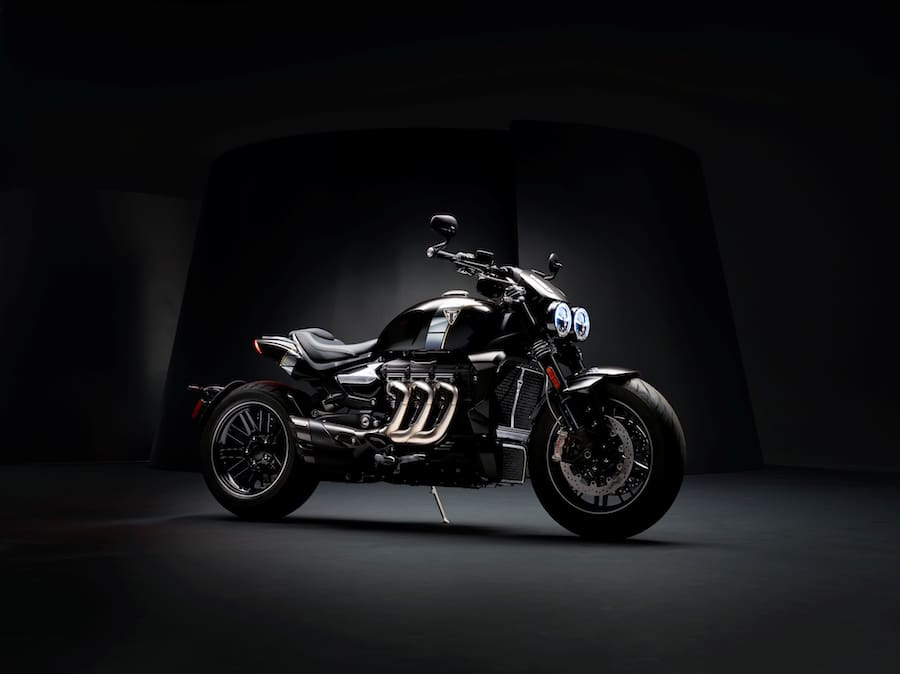Harley-Davidson FXDR
The FXDR is the latest in a raft of new Softail models released by the Motor Company in the last 12 months and while to the untrained eye it looks every bit the bike you’d expect to roll off what’s one of the world’s most famous production lines, it’s actually quite a bit different from the H-D norm.
For a start, it’s the only Softail to boast an aluminium swingarm, and pretty flash looking one at that. According to H-D, it reduces the weight of the 10.8kg steel item by 43 percent to 6.2kg, which has a significant impact on the bike’s unsprung weight. Speaking of weight, the traditional steel subframe and fender supports are aluminium on the FXDR and the steel guards are swapped out for carbon fibre.
It’s how a traditional marque like Harley does sport, or perhaps a better word is performance. And since the FXDR can also lay claim to having the most about of lean angle of any current-model Softail (that’s 32.6 degrees to the left and 32.8 to the right), it’s probably rather successful. As well as the footpeg placement, the improved lean angle is also achieved through the shape of the two-into-one exhaust which, in true Harley fashion, has been used effectively as both form and function.
It polarised people, but I love the styling of the FXDR which I reckon is the most successful in the black-and-orange version (the white option is far too reminiscent of the the firm’s now-obsolete water-cooled V-Rod for my liking). From the side, the stubby rear end matched to the raked-out front is really easy on the eye thanks to a clever integration of the oil-cooler shroud. From the front, that dragstrip-inspired air intake hogs the spotlight and from behind, it’s all 240-section Michelin rubber.
But out on the road, it was that tyre which took a while to get used to. With all that awesome grunt, noise about lean-angle ability and even a marketing video shot at High Plains Raceway in Colorado, a 240-section rear hoop isn’t actually conducive to intuitive and effortless cornering. In fact, to get it through a set of relatively close corners at anything resembling speed takes quite a lot of effort. However once I figured out just how much input it required from me to muscle it in and out of turns, then it became quite a fun thing to ride at pace.
The rear suspension did its job. Admittedly, I wound out the remote preload adjuster to the firmest setting when I picked up the bike and found no reason to tweak it.
Despite its 34-degree rake angle and 19-inch front wheel making it quite a slow turner, the feedback through the non-adjustable 43mm up-side-down fork is excellent. Helped, no doubt, by the 120-section Michelin tyre, the front-end gives you all the confidence you need to try and find the limits of the lean angle and scrape something on the road. And yep, I’ll admit it’s harder than it looks.
But by the time you’re back on the gas and accelerating out of the corner, you’ve forgotten about what may or may not of caught the asphalt as you and 303kg of American muscle are hurtling towards the next corner where the braking package really needs to bring its A-game.
On paper, it’s a fairly customary brake set-up; a pair conventionally mounted four-piston calipers biting a couple of small-ish 300mm discs at the front matched to a twin-piston/292mm disc affair at the rear, ABS-equipped of course. But when all that grunt has flung a bike and rider weight of 365kg rapidly towards a sharp bend you need more than a customary stopping time at your disposal. I found the brakes to have plenty of power for what I asked them to do and with more than enough feel through the lever, but I suspect anyone much heavier than me may find themselves wishing there was a bit of adjustment in the fork preload if they’re a late and heavy braker. But if you remind yourself it’s a cruiser, albeit a cruiser based around performance, then would-be owners will still be happy with your investment, even heavy late brakers.
They certainly will be when it’s back in the shed, ticking as it cools down. There’s plenty to look at, lots to admire and if you’re the person who’s drawn to the FXDR enough to slap $35K down on the desk of your H-D dealer, then you’re going to love it. I lost count of how many times the H-D logo appears on this bike. Be it the bright-orange laser-etched logos on the wheels, the six times the words appear on the top of the fork, the bar-and-shield logo on the fuel cap (which, incidentally, isn’t lockable), the mirrors, the front-side of the intake, moulded into the shoulder of the tyres, the calipers, the coil casing – even the footpeg rubbers get a logo. And that’s before we even talk about the standard placements like tank, yoke and engine cases.
And not just you, plenty of people (including the wallopers) are drawn to it, regardless of where I had it parked there was generally someone checking it out – whether they were into bikes or not – its ability to attract the mainstream with a largely unsociable lump of metal is something Harley-Davidson does amazingly well.
It’s seat is a hugely accessible 720mm, but the bike is really wide. So any distance I saved on seat height, I lost on what my legs needed to go around to find the ground, but potential owners would be more concerned about the weight of the thing before the seat height – it’s heavy, especially when you’re trying to negotiate the thing in a tight shed or car park. But it does carry its weight low enough to be utterly predictable.
Sitting in the seat, the cockpit is clean and well thought out. Set behind a small but aesthetically pleasing cowling surrounding the LED daymaker headlight, the flight deck of this rocket ship is a pretty nice place to be. The fluro-red R on the FXDR logo emblazoned on the top yolk is there to remind you of its performance credential and its minimalist dash has all the hallmarks of a custom-cum-racer, which I like.
The small dash is dating quickly in these times of customisable full-colour touchscreen displays, however its analogue LCD display is informative enough, with your speed, fuel level and gear-selection indicator always displayed, with the ability to scroll through a pair of trip meters, a tacho, a clock and your range until empty via a button on the left-hand switch block.
Speaking of switchblocks, the FXDR uses Harley’s obligatory left- and right-side indicator buttons which always takes some getting used to, but I always eventually do.
Though I doubt you’d get used to the challenging but thrilling encounter of muscling H-D’s most performance oriented Softail through your favourite set of corners any time soon. I’ll admit that well over $35K is a hell of a lot of money to spend on a motorcycle with such a narrow focus as the FXDR. But if it’s a unique and head-turning power cruiser you want in your garage, one that will reward both your ego and your power cravings with delightfully pure and linear grunt, then it just may be worth it.
There’s a Italian power cruiser that’s got a few things to say about the FXDR and there’s one on its way from Britain that’ll give it a run for its money, too
Read more about Harley-Davidson FXDR

2019 Ducati XDiavel
While over 600cc down on the FXDR, the 1262cc Testastretta engine is a far more advance engine than the Milwaukee-Eight. Using the firm’s Desmodromic Variable Timing system, it’s good for 147Nm of torque at 5000rpm (compared to the FXDR’s 160Nm at 3500rpm), though the bike’s ready-to-ride weight of 247kg, which is 56kg lighter than the FXDR, makes it feel pretty much on par.
The XDiavel S’s lean-angle capabilities are better, with Ducati claiming 40-degrees of lean angle on both sides of the bike and, despite it wearing the same-width 240mm rear tyre, my experience on the XDiavel was that it didn’t require as much input from the rider in order to get it where I wanted it to go.
Tech-wise is where it really stands clear of the FXDR, with its switchable engine maps, cornering ABS, traction control, launch control, cruise control, multimedia system through its TFT full-colour dash, even backlit switchblocks.
The XDaivel starts $27,990 (plus on roads) for the base model with the top-spec S-model starting at $32,990 (+ORC) for the black version.
But it isn’t a Harley, and there’s plenty of people out there who, if they’re going to own a cruiser, it can only be from the Milwaukee giant. And as a rider who’s introduction to motorcycling all those years ago was on the back of dad’s heavily customised Shovelhead, I’d probably have to agree.
There’s a Italian power cruiser that’s got a few things to say about the FXDR and there’s one on its way from Britain that’ll give it a run for its money, too
Read more about the Ducati XDiavel

2020 Triumph Rocket III
If anything screams power cruiser it’s Triumph’s Rocket III and we’ve clapped eyes on the yet-to-be revealed 2020 version. Tipped to be as large as 2500cc, it makes gains in capacity what the Ducati loses to Harley and its torque output is likely to make the FXDR whimper in shame.
Already capable of 221Nm when it existed in its original 2300cc form, the yet-to-be revealed power cruiser will be aiming for the crown in the production bike torque front.
Like the roadster-style standard Diavel and the feet-forward XDiavel, the Rocket III will likely be offered in two versions putting it head-to-head with the FXDR. If recent offerings from Triumph are anything to go by, its likely to be dripping in the latest tech and while that rear hoop is tipped to be 250mm or even wider, we’ll have to wait to see how it handles on the road and what sort of lean angles are realistically capable.
All eyes will be on November’s round of international motorcycle shows when official specs and details are released with the bike’s global unveiling. Watch this space.
Read more about the Triumph Rocket III

Test Kel Buckley Photography Mark Dadswell











